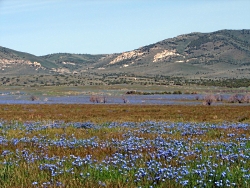
years after seeding
of Devil’s Playground.
Courtesy & Copyright 2012
Jim Cane, Photographer
 Native grasses established
Native grasses established
two years after
seeding Scooby Fire.
Courtesy & Copyright 2012
Jim Cane, Photographer
 Native sweetvetch farmed
Native sweetvetch farmed
for seed production.
Courtesy & Copyright 2012
Jim Cane, Photographer
Restoring degraded plant communities has a long history on Utah’s public lands. The problem began with the transcontinental railroad, which enabled transport of livestock from Western rangelands to Eastern cities. By the late 1800s, vast flocks of ravenous sheep roved Utah’s unregulated wildlands. Montane summer pastures were stripped bare, so snow melt and summer rainfall washed across the ground unchecked, carving deep gullies. Downstream settlements, such as Logan and Manti, incurred ruinous floods and mud flows. Teddy Roosevelt responded to local pleas for federal control by designating our first national forests in Utah.
Soon thereafter, the fledgling Forest Service created the Great Basin Research Station east of Ephraim Utah. It was charged with discovering the cause of the floods. Within two years, large grazing exclosures were built in nearby mountain meadows by the Agency’s first range ecologist, Arthur Sampson. His research quickly linked overgrazing with denuded meadows, eroding soil and the floods. By 1914, Sampson advocated for rest rotational grazing. To then restore the impacted plant communities, there followed a landmark program at the Station to evaluate plants that could revegetate the degraded watersheds, and later, restore big-game winter range. Led by Perry Plummer, the Station evaluated the performance of 1000 species of shrubs, grasses and wildflowers, some tested in most of Utah’s plant communities. Methods to better collect, store, plant and germinate seeds underpinned the restoration of plant communities that, along with the 1934 Taylor Grazing Act, ended Utah’s frequent canyon floods.
That public research continues with the Great Basin Native Seed Selection and Increase Project. Today’s goal is to restore plant communities after rangeland fire, stalling and eventually reversing the invasion of flammable exotic grasses and weeds in the Intermountain West. Dedicated warehouses in Ephraim, Ely and Boise can store up to 3 million pounds of seed, a testimony to further progress in farming and collecting desirable seed. The seed is spread by aircraft over rocky places, while on gentler slopes, versatile rangeland seeders can place each kind of seed at the right depth, from tiny sagebrush to big grass seeds, all in a single pass over uneven ground. For every planting that takes hold, another weedy legacy of hundred-year-old overgrazing is finally repaired.
This is Linda Kervin for Bridgerland Audubon Society.
Credits:
Images: Courtesy & Copyright Jim Cane
Text: Jim Cane, Bridgerland Audubon Society
Additional Reading:
https://wildfiretoday.com/page/2/
https://www.fs.fed.us/rm/boise/research/shrub/greatbasin.shtml
https://www.fs.fed.us/rm/boise/research/shrub/projects/plant_guides.html
